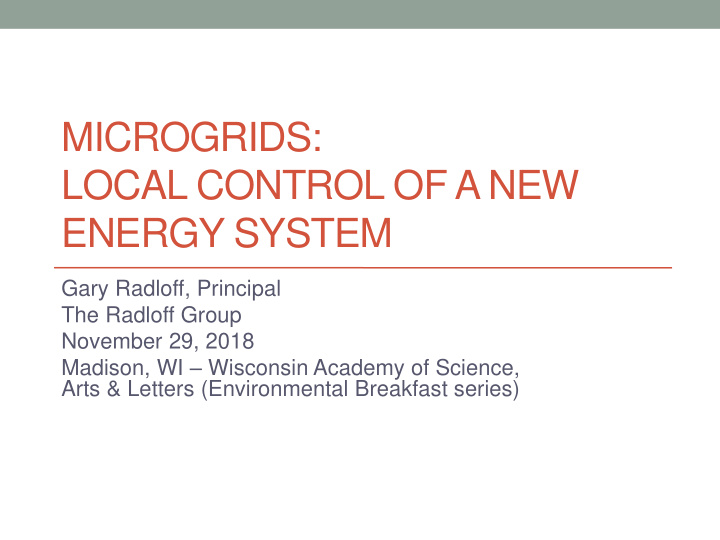



MICROGRIDS: LOCAL CONTROL OF A NEW ENERGY SYSTEM Gary Radloff, Principal The Radloff Group November 29, 2018 Madison, WI – Wisconsin Academy of Science, Arts & Letters (Environmental Breakfast series)
Microgrids & Advanced Distribution Networks Enables greater efficiency and resiliency. Helps address $100B in business losses due to power disruptions. Deployed at hospitals, military bases, factories, more Offers new products and supply chains for Wisconsin’s electrical equipment manufacturers.
Energy System Change • The electric grid of tomorrow will experience more change in the next 20 years than in the past 100 years combined. • Who will lead and who follow? • How much will change be market and consumer driven? How much by policy change?
De-carbonization/Digitalization/De-centralization The 3D’s of change: The century-plus old electric system is undergoing three tectonic shifts: Analog to Digital: The electric energy system, especially the grid, has gone from analog to digital, with millions of new devices attached to the grid from solar panels to refrigerators; Centralized to decentralized: The electric energy system has gone from centralized power production to more decentralized, like the shift from mainframe computers to smartphones; Multiple directional data and energy flows: The electric energy system has gone from one-way flow of electricity (and data) to having it flow in multiple directions. Remember, this is an energy system that changed relatively little for over 100 years until the last decade. Customers today are choosing clean energy or what I like to call “Advanced Energy Systems.”
What is a microgrid?
What is a microgrid?
Powering connections with microgrids
Multiple value propositions
Growing Electricity Customer Options (DERs = New supply & demand paradigm) • Buy it : the legacy grid & utility are no longer the only option • Make it : first challenge to status quo with solar PV, wind and biogas distributed generation options • Eliminate it : energy efficiency or negawatts are raising the bar with innovative solutions and goals to reduce or eliminate waste. • Store it : (energy storage) emerging disruptive to change to address multiple grid services, intermittent renewables,& potentially dispatch it yourself • Shift it : demand response or demand flexibility is evolving from a traditional solution to a flexibility tool complemented by other DERs • Manage it : Microgrids, virtual power plants, smart grid, home & business management software, algorithms to help prosumer buy and sell energy when the market is favorable. New business model ( aggregate it ) • Sell it or share it : the advent of transactive energy and blockchain technology advances the concept of a new energy value proposition • Reduce it : No investments in overbuilt generation and fewer system losses.
DERs allow for a paradigm shift
88 GW of Demand Flexibility in 2023
Solar plus battery cost decline in 10 years
Battery Services Three Stakeholders
Network Platform = Value Proposition
How VPP works
Virtual Power Plant (VPP) & Distributed Energy Resource Management Systems (DERMs)
Transactive Energy & blockchain
Some key takeaways about microgrids • Microgrids can island – meaning operate independently when the grid goes down (to maintain critical infrastructure). • Microgrids enable greater system-wide efficiencies because they are located closer to aggregate loads and DERs. (Including opportunities for CHP i.e. heating). • Microgrids utilization of smart controlers, smart inverters, sophisticated algorithms, sensors and controls, will balance intermittent generation & link with the cloud (IoT). • Microgrids catalyze the pathway to local energy markets with connections to grid services, new value propositions and transactive energy markets. (DSO & aggregators).
CONTACT INFORMATION Gary Radloff, Principal The Radloff Group glradoff@gmail.com 608-347-9681 http://energy.wisc.edu/about/people/radloff
Wisconsin is one of only ten states out of 50 without energy planning
State Distribution Planning (Source: DOE)
Discussion: What kind of energy system do you want to see in the future? • Integrated Distribution Planning (IDP) • Grid Modernization (two-way energy flows and communications flows). Energy democratization. • Connected devices, sensors and controls, and robust public accessible data (will improve efficiency, create new value propositions and allow transparent policy goals. • Distributed Energy Resources (DERs) and Non-Wire Alternatives (NWAs) including energy storage, demand response, next generation efficiency, net-zero buildings create a new supply and demand paradigm and manage system over builds. • Local energy markets, peer-to-peer trading and sales.
Distribution System Platform (Avista)
Systems Thinking: Future of clean, efficient, resilient energy systems
Is their an aggregator in your future?
Less is more equals flexibility? • Residential per capita energy load has fallen 7 percent since 2010 partially due to gains in efficiency, building and appliance codes, and increased behind-the- meter generation have been implemented. • How can alternative revenues replace traditional cost-of- service billing and related infrastructure investments? • How much impact will increasing use of electric vehicles and battery charging impact the grid? • Is this an opportunity for grid service flexibility? • This will likely only occur if dumb distribution planning and investments are replaced by smart clean energy and distributed energy resource (DER) deployment.
What is flexibility? • Ramp – the ability to respond rapidly and over sustained periods to changes in load or generation. • Over-generation – the grid needs to be able to absorb or shift excess generation. • Frequency – the grid needs to be keep generation and load in balance at all times. • Voltage – maintain voltage within acceptable limits. While the other flexibility needs are required at a larger system level, voltage is a local requirement and must be managed at a circuit level. • Flexible resources can be used to reduce system peaks and flatten net load
States considering performance-based rates (Source: Forbes & Sonia Aggrewal)
Today we are in a market transition
Solar Technology Innovation (NREL)
U.S. Energy Consumption 2017
PV System Cost Declines
Recommend
More recommend